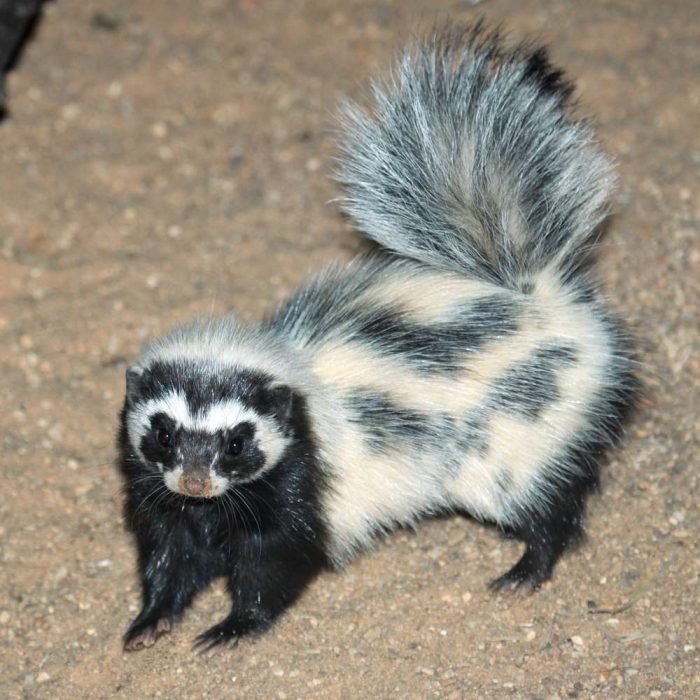Southern Steenbok
( steinbuck or steinbok )
- Raphicerus campestris campestris
- IUCN Status: Least Concern
- Trend: stable

General Information
The Southern Steenbok is a small antelope and one of two main subspecies of steinbuck, namely, from southern Africa and East Africa.
Description
A small antelope with a lush coat of any shade from fawn to rufous or orange. The underside, including chin and throat, is white, as is the ring around the eye. Ears are large with “finger-marks” on the inside. Males have straight, smooth, parallel horns 7 to 19 cm long. There is a black crescent-shape between the ears, a long black bridge to the glossy black nose, and a black circular scent-gland in front of the eye. The tail is not usually visible, being only 4 to 6 cm long.
Fun Facts
The Southern Steenbok is a subspecies of steenbok found in Zambia. They are monogamous, which is unusual among antelopes—with pairs staying together for years.
When pursued, they sometimes duck into abandoned aardvark burrows to hide.
Their Zulu name (“steenbok”) means “stone buck,” referring to their habit of freezing statue-still.
Ecology & Behaviour
Steenbok are active during the day and the night though they rest under shade on particulary hot days. While resting, they may be busy grooming, ruminating or taking brief spells of sleep. They cannot reach above a meter when browsing for food so their diet consists of low-level vegetation, fruits, tubers, roots, forbs and shrubs. They are almost entirely independent of drinking water, gaining the moisture they need from their food.
At the first sign of trouble, steenbok typically lie low in the vegetation and If a predator or perceived threat comes closer, a steenbok will leap away and follow a zigzag route to try to shake off the pursuer. Escaping steenbok frequently stop to look back, and flight is alternated with prostration during extended pursuit. They are known to take refuge in the burrows of aardvarks. It often eludes it’s predators by darting down old burrows. Known predators include Southern African wildcat, caracal, jackals, leopard, martial eagle and pythons.
Distribution & Habitat
Steenbok live in a variety of habitats from semi-desert to open woodland and thickets, including open plains, stony savannah, and Acacia–grassland mosaics. In Zambia they are common in the Kafue National Park (open plains and dambos), South Luangwa NP (mopane scrub and riverine edges) and the Lower Zambezi (thornveld and grassy foothills).
In Southern Africa, it occurs in Angola, Namibia, South Africa, Eswatini, Botswana, Mozambique, Zambia, Zimbabwe and probably Lesotho.
Diet
Steenbok are active during the day and the night though they rest under shade on particulary hot days. While resting, they may be busy grooming, ruminating or taking brief spells of sleep. They cannot reach above a meter when browsing for food so their diet consists of low-level vegetation, fruits, tubers, roots, forbs and shrubs. They are almost entirely independent of drinking water, gaining the moisture they need from their food.
At the first sign of trouble, steenbok typically lie low in the vegetation and If a predator or perceived threat comes closer, a steenbok will leap away and follow a zigzag route to try to shake off the pursuer. Escaping steenbok frequently stop to look back, and flight is alternated with prostration during extended pursuit. They are known to take refuge in the burrows of aardvarks. It often eludes it’s predators by darting down old burrows. Known predators include Southern African wildcat, caracal, jackals, leopard, martial eagle and pythons.
Reproduction
Steenbok are active during the day and the night though they rest under shade on particulary hot days. While resting, they may be busy grooming, ruminating or taking brief spells of sleep. They cannot reach above a meter when browsing for food so their diet consists of low-level vegetation, fruits, tubers, roots, forbs and shrubs. They are almost entirely independent of drinking water, gaining the moisture they need from their food.
At the first sign of trouble, steenbok typically lie low in the vegetation and If a predator or perceived threat comes closer, a steenbok will leap away and follow a zigzag route to try to shake off the pursuer. Escaping steenbok frequently stop to look back, and flight is alternated with prostration during extended pursuit. They are known to take refuge in the burrows of aardvarks. It often eludes it’s predators by darting down old burrows. Known predators include Southern African wildcat, caracal, jackals, leopard, martial eagle and pythons.
Conservation
It is listed on the IUCN red list as “Least Concern”
















